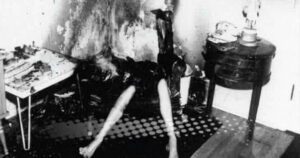In September 2017, 70-year-old John Nolan was walking on a street in London (UK) when his body suddenly burst into flames. People around immediately put out the fire and took him to the hospital, but John still passed away due to severe burns. At that time, doctors and scientists linked this event to similar cases of spontaneous human combustion (SHC) in history.

Mysterious Cases of Spontaneous Human Combustion
This mystery dates back to 1641, when Danish physician Thomas Bartholin (1616-1680) described the death of Polonus Vorstius in his book Anatomicarum Rariorum, which focused on medical phenomena that had not yet been explained. This is considered the first case of spontaneous human combustion on record.

Specifically, Polonus was an Italian knight with normal health, but while at his home in Milan in 1470, he drank some strong liquor and began to vomit flames before bursting into flames himself. However, strangely, there was no heat source around him to ignite his body.
In France, a case of SHC was also recorded in 1725, when a Parisian innkeeper was awakened by the smell of smoke and discovered his wife – Nicole Millet, had turned to ashes while sleeping on a straw mattress with no fire nearby. All that remained were the skull, a few pieces of the spine, and lower legs. Wooden objects around her were not damaged at all.
As no explanation could be found for Nicole’s spontaneous combustion, her husband was accused of intentionally killing her. Fortunately, he appealed and the judge agreed on the natural process of human combustion. Part of the husband’s exoneration was thanks to the presence of surgeon Claude-Nicolas Le Cat, who was there when the incident occurred. Nicole’s death was then declared as “a visit from God”.
Later on, cases of spontaneous human combustion became more common in the 16th century, after the famous English author Charles Dickens used it as an idea for a murder case in his novel Bleak House. When literary critics criticized Charles for introducing a “fantastical” element, he explained based on research that by that time there had already been 30 cases of SHC.

It is often reported that at the scene of cases of SHC, objects surrounding the victim appear to be unharmed.
By the 18th century, more authoritative and credible reports on the phenomenon of SHC began to appear in newspapers. The London Journal of Phisology in England published the case of 62-year-old Countess Cornelia Bandi, which left many people terrified.
In 1731, after dinner, Cornelia was not feeling well and returned to her bedroom to rest. By morning, the maid found the mistress had turned into a pool of pink ash, with her body burned to the point where only her head and limbs remained. There was an unpleasant smell of oily smoke in the room, and the window had a yellowish, foul-smelling liquid residue.
In 1986, the remains of former firefighter George Mott were found in his house in Crown Point (USA). All that remained of him were his skull, legs, and scattered rib bones. No one could explain why he had suffered such a terrifyingly sudden combustion.
The Common Point Among These Unlucky Victims
According to Ancient Origins, over the past 400 years, more than 200 cases of humans spontaneously combusting to death without any external factors have been recorded in the world.
Later on, the topic of SHC was published in the British medical journal in 1938, which quoted a book published in 1823 called Medical Jurisprudence. According to this book, experts listed some commonalities among cases of SHC, such as:
- Most of the victims are elderly women with chronic alcoholism.
- The entire body is burned completely, leaving only bones and limbs.
- The fire does not cause any damage to surrounding objects.
- They spontaneously combust without any external influences.
- Almost all cases of SHC have been discovered after the incident, and to this day, no one has directly witnessed this phenomenon.
“The Wick Effect” – The Most Feasible Hypothesis That Medicine Speculates
As the rare disease SHC occurred more frequently, experts firmly asserted that the victims did not die from fire in their surrounding environment, but rather they themselves became fuel and spontaneously combusted. In ancient times, it was rumored that this was God’s punishment for alcoholics.
However, later on, the great German chemist Liebig conducted numerous experiments to refute the idea that SHC originated from alcohol. He injected a large amount of alcohol into mice and used every possible catalyst to make them spontaneously combust. The results showed that even when the mice had a blood alcohol concentration of over 70%, they were not more flammable than before.

As of today, the theory that is most widely accepted by scientists to explain SHC is called the “wick effect”. Specifically, the human body at this point is like a candle with a wick inside, covered by a layer of flammable wax made from fatty acids. The flame burns the wick and the fatty wax, keeping it burning continuously.
Regarding the human body, the fat in the body plays the role of a combustible material, while the victim’s clothing and hair act as the wick. When there is a heat source, clothing will burn first and release the layer of fat under the skin, causing the fat to melt and ignite itself. They act like a wax to keep the wick burning, and this will continue as long as there is fuel.
Supporters of this theory all state that this is the answer to the question of why the victim’s body is almost completely burned but the surrounding environment is hardly damaged.
The Mystery Remains a Mystery
Although the “wick effect” is the most plausible hypothesis, it is not entirely convincing. It cannot fully explain why victims remain motionless during burning, nor can it explain why surrounding objects are often unaffected by the fire.
In addition, SHC cases always occur indoors, when the victims are alone and near sources of heat. Currently, there have been no recorded cases of natural animal combustion, so it seems that SHC only occurs in humans.
Furthermore, experts also affirm that the human body must reach a temperature of about 3000 degrees F (1648 degrees C) to completely burn to ashes, but with only a spontaneous flame, it cannot burn strongly enough to reach that temperature. Therefore, the SHC phenomenon is still an unsolved mystery.






